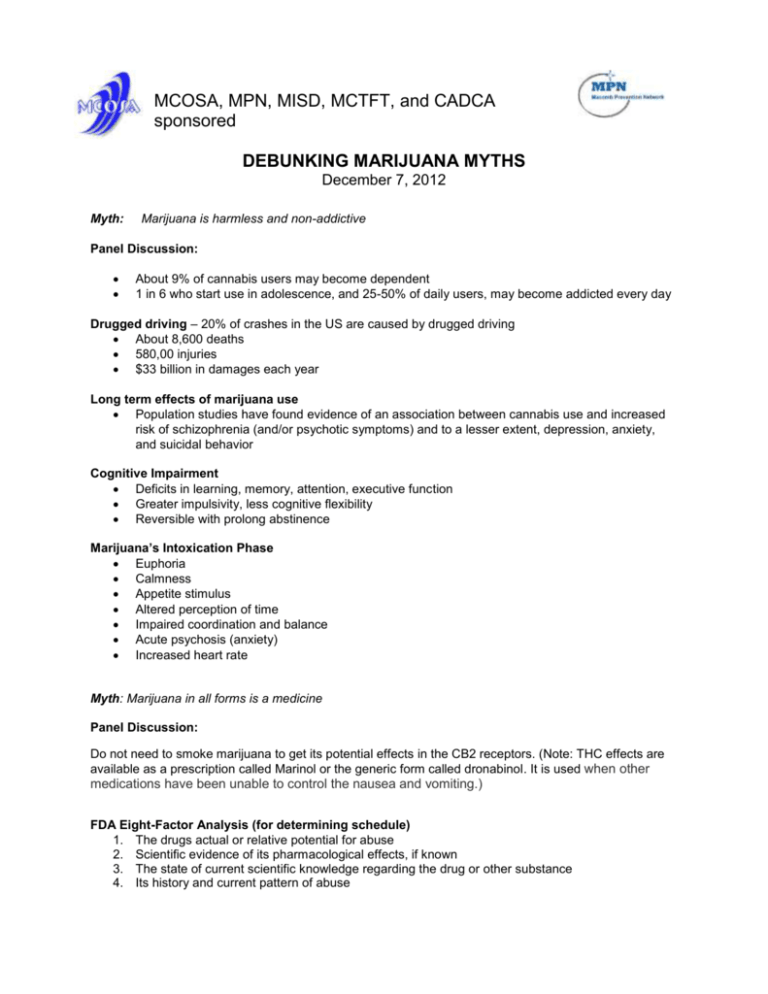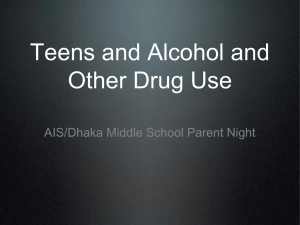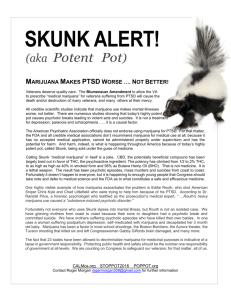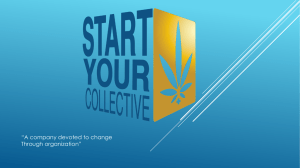Notes - Macomb County office of Substance Abuse
advertisement

MCOSA, MPN, MISD, MCTFT, and CADCA sponsored DEBUNKING MARIJUANA MYTHS December 7, 2012 Myth: Marijuana is harmless and non-addictive Panel Discussion: About 9% of cannabis users may become dependent 1 in 6 who start use in adolescence, and 25-50% of daily users, may become addicted every day Drugged driving – 20% of crashes in the US are caused by drugged driving About 8,600 deaths 580,00 injuries $33 billion in damages each year Long term effects of marijuana use Population studies have found evidence of an association between cannabis use and increased risk of schizophrenia (and/or psychotic symptoms) and to a lesser extent, depression, anxiety, and suicidal behavior Cognitive Impairment Deficits in learning, memory, attention, executive function Greater impulsivity, less cognitive flexibility Reversible with prolong abstinence Marijuana’s Intoxication Phase Euphoria Calmness Appetite stimulus Altered perception of time Impaired coordination and balance Acute psychosis (anxiety) Increased heart rate Myth: Marijuana in all forms is a medicine Panel Discussion: Do not need to smoke marijuana to get its potential effects in the CB2 receptors. (Note: THC effects are available as a prescription called Marinol or the generic form called dronabinol. It is used when other medications have been unable to control the nausea and vomiting.) FDA Eight-Factor Analysis (for determining schedule) 1. The drugs actual or relative potential for abuse 2. Scientific evidence of its pharmacological effects, if known 3. The state of current scientific knowledge regarding the drug or other substance 4. Its history and current pattern of abuse 5. 6. 7. 8. The scope, duration, and significance of abuse What, if any, risk there is to public health? Its psychological or physiological dependence liability Whether the substance is an immediate precursor of a controlled substance Myth: Law enforcement has better things to do Panel Discussion: If you are the target of that investigation, you will always think law enforcement has better things to do. When it comes to marijuana are [enforcement] teams that work on that issue – just like enforcement works on alcohol, drugs, homicide divisions, etc. If the laws are on the books, it’s their duty to enforce them. There is an “overall” view that law enforcement is focusing all their attention on marijuana and marijuana possession. There is an overall view that enforcement is focusing all of its resources on marijuana, especially marijuana possession, especially if you look at the FBI statistics. What gets lost in those numbers is that the vast majority of those who get arrested for possession are not being handcuffed or taken to jail or spending time in jail. That type of arrest is no greater than a parking or speeding ticket. More important is what law enforcement is doing beyond arrest… Are our jails and prisons filled with people locked up because of marijuana possessions? The answer to that question is NO. About 1/10th of 1% according to a Department of Justice Survey of those in state prisons are there for any kind of marijuana possession violation. In fact, federal prison has no one there with marijuana possession. Is law enforcement out there just looking for people growing marijuana? No, that is a misconception. If an officer arrests someone for growing marijuana, they will usually get probation and pay a fine. Then while they are on probation they get some other charge and that’s why they end up in prison. There are other crimes associated with marijuana use –break-ins, assaults, homicide, etc. Drugs and crime are linked in three fundamental ways – (1) the crimes to obtain money to buy drugs; (2) the crime caused as a result of being high on a certain drug; and (3) turf wars over selling. Marijuana fits in the first 2 categories. Myth: Since alcohol and tobacco are legal, we should legalize marijuana Panel Discussion: If we legalize marijuana we will have a whole new set of problems associated with it, including the cognitive problems, problems associated with health and mental illness, and drugged driving. So legalizing it just puts out another substance that has addictive properties and other problems for the country. If it were legalized, what kind of additional cost would we be looking at? Rand Corporation did a study on that looking at what would happen if California legalized it. They found out that the price of marijuana would be reduced about 80%, and because the price would fall dramatically there would be a significant increase in consumption. There was also issues about tax markets – if you’re going to legalize it for tax reasons, a lot of people will evade that and go underground because they can evade the tax issue and still make a profit on it. Tax Revenue vs. Cost Federal and state alcohol taxes raises $14.5 billion, covering only about 6% of alcohol’s total cost to society. Federal and state tobacco taxes raise only $25 billion, covering only about 13% of tobacco’s cost to society. There would still be law enforcement issues – for example it still would not be legal for minors, issues would increase around driving while intoxicated. Law enforcement arrest a million more people a year for alcohol related incidence than for all drugs combined. That’s because of driving while intoxicated, public drunkenness, and violation of liquor laws. This figure does not cover the violence related to alcohol. There are 2.7 million arrests a year for alcohol, and 1.6 million for drugs. Legalization will not ease any kind of burden on law enforcement. Myth: Legalizations will end crime involving marijuana Panel Discussion: Using California as an example, look at the increase in home invasions, and residents living in the marijuana growing regions have a greater need to secure their homes. It’s creating a lot more environment for crime and victimization. Cost of Substance Abuse: Total overall cost of substance abuse in the US, including productivity, health, and crime-related costs, exceed $600 billion annually. Includes approximately: $235 billion for alcohol $193 billion for tobacco $181 billion for illicit drugs Myth: Legal and taxed marijuana will solve all government budgetary problems Panel Discussion: The amount of money that will be taxed will be offset by the health problems and loss of productivity. Social costs – from studies that are going on it is showing that marijuana use is affecting brain development, especially when it’s used by youth, so the idea that we are growing a generation that will be less competent than they can be is a tremendous social cost, and will affect the competiveness of our students and our country. Six percent of high school students admit to smoking marijuana every day. That 6% is virtually unemployable, because most companies drug test. If marijuana is made legal companies are still going to drug test just as companies currently test for alcohol which is legal. Myth: There are countries where marijuana decriminalization has been successful (for example, the Netherlands) Panel Discussion: For the first 10 years or so there wasn’t an increase in marijuana use in the Netherlands, then in the mid 80’s people realized that they have a law that they aren’t making any money off of, so let’s do something. There was a rapid commercialization of marijuana and what happened after that was a tripling of youth marijuana use for lifetime use by 1996, and there was doubling for annual use in adults in the Netherlands. The Netherlands are now the top country for marijuana dependence, and now they are doing a 180 degree turn on marijuana. They are reversing their policies, and they will close 70% of their coffee shops where this product is sold. They will only be allowing Dutch residents to buy marijuana. This will be in effect as of 2013. Myth: There is nothing we can do to prevent marijuana use. Panel Discussion: Prevention is happening in this country. The media does not show the down side of marijuana, like they do for alcohol. We have made great strides in the last 20 years of decreasing tobacco and alcohol use because of the great public outcry, hopes that some of this “ire” can be put towards drugs, because we shouldn’t have to learn from our painful experience of living with a tobacco industry that went completely unregulated, that marketed to kids, that claimed that these were “medicinal” (tobacco was once thought of as “medicinal” – ads would show doctors who would recommend smoking). It is worrisome that we are seeing history being repeated again, and the last thing we would want to see is marijuana legalized with these industries. Tobacco growers are in place to become the supplier of marijuana. Is there treatment available? There is a need to deal with the withdrawal symptoms, because it is subtle and not like it is with heroin or nicotine, but it’s enough to make people uncomfortable, interfere with their sleep, which is enough to get them to go back to using. Marijuana related treatment admissions have more than doubled in the past 10 years, even though use rates have stayed the same. Since marijuana is stronger today than in the past, more kids are in treatment than for all drugs and alcohol combined. THC potency has increased over the years. In the 80’s it was 2-3% potency, and now it is 1011%. THC is the main psychoactive ingredient in marijuana that makes people feel high. Content Providers: Jason Poore, Special Agent, Tennessee Bomb and Arson Section, Knoxville, TN Jason Poore has been in law enforcement since 1999 and is currently employed as a Special Agent with the Tennessee Bomb & Arson Section in Knoxville, Tennessee. Poore was assigned to the Tennessee Governor's Task Force on Marijuana Eradication for nine years. In that position, he investigated outdoor marijuana cultivation, indoor marijuana growing operations and other narcotic violations. He also enforced the state liquor laws and regulations through undercover and overt investigations and operations. Kevin Sabet, Ph.D., Director of the Institute on Drug Policy (IDP) at the University of Florida, Asst. Professor in the College of Medicine, Department of Psychiatry Kevin Sabet has been working on drug policy issues for more than eighteen years. From 2009-2011, he served in the Obama Administration as the Senior Advisor to Director Kerlikowske at the White House Office of National Drug Control Policy (ONDCP). Prior to that appointment, he worked for ONDCP on research, policy and speech writing in the Clinton and Bush Administrations. Sabet is a staff columnist at TheFix.com and a regular contributor to opinion-editorial pages worldwide, including the Washington Post, Huffington Post, New York Times, Vancouver Sun, San Francisco Chronicle,Seattle Times, CNN, CNBC, and more than a dozen other media outlets. Susan Weiss, Ph.D., Associate Director for Scientific Affairs for the National Institute on Drug Abuse (NIDA), at the National Institutes of Health (NIH) Susan Weiss serves as a senior advisor to the NIDA Director, and provides scientific guidance and oversight to staff of NIDA who are responsible for such key areas as communications, program development, science planning and policy analysis, and government relations. Previously at NIDA, Weiss served as the Chief of the Science Policy Branch, where she supervised a dozen staff working on various aspects of drug abuse and addiction. This broadcast may be viewed at: http://www.mctft.com; click on “Broadcasts/Videos”, Click on “Past Broadcasts” then look for the program you want to view. Links from Debunking Marijuana Myths: National Institute on Drug Abuse - http://www.drugabuse.gov/ NIDA for Teens - http://www.teens.drugabuse.gov/ NIDA's Research Dissemination Center - http://drugpubs.drugabuse.gov/ Kevin Sabet - http://kevinsabet.com/ Massachusetts Prevention Alliance - http://www.mapreventionalliance.org/ American Branding Association - http://americanbranding.org/ Danvers Cares - http://danverscares.org/ Wayland Cares - http://waylandcares.org/ Massachusetts Medical Society - http://www.massmed.org//AM/Template.cfm?Section=Home6









